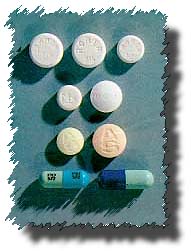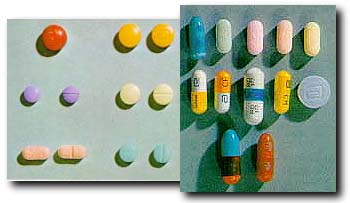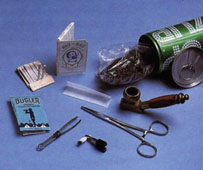What is a drug?
Crack
Barbiturates
Heroin
Other Drugs
Alcohol
Cocaine
LSD
Marijuana
Methamphetamines
Tobacco
Have you seen
a drug and don´t know what it is?

Young people use drugs to feel stronger, more energetic, and more decisive.
As with other stimulants, some drugs are legally prescribed by doctors
for various reasons, such as for weight loss, hyperactive children, or
a rare disease called narcolepsy. Examples of stimulants are amphetamines,
methamphetamines, Ritaline and Preludine. Included in this category are
cocaine and rock cocaine or crack, a deadly and highly addictive form of
cocaine
But Large doses of drugs can cause repetitive grinding of the teeth,
weight loss, touching and picking of the face, and paranoia. An overdose
can result in dizziness, tremors, agitation, panic, hostility, abdominal
cramps, chest pains and palpitations. Extreme overdoses can result in cardiac
arrest, strokes or death.
Kinds of drugs
Crack
Crack and rock cocaine are forms of cocaine that are extremely
addictire and very dangerous. (Crack and rock cocaine are nearly identical
drugs, hence they will be referred to as crack only.) Crack has quickly
become a major problem in this country because it is inexpensive, readily
available, and highly addictlye. Crack comes in white to tan pellets and
is sold in small vials. It is smoked in glass pipes and makes a crackling
sound when it is smoked. Paraphernalia associated with crack includes glass
pipes called "base" pipes, homemade pipes, and small vials used to store
the drug.
Crack is absorbed into the blood stream through the lungs in
just a few seconds. If your teenager is using crack, he or she will temporarily
appear euphoric, extremely alert, and highly energetic. Other symptoms
include dilated pupils, loss of appetite, elevated heart rate, elevated
respiration rate, and higher body temperature. The high lasts only a few
minutes, leaving an intense depression called a "crash" and an immediate
desire for more of the drug. The severe addiction associated with crack
stems not only from a desire for the euphoria of the high but a desire
to escape from the "crash" following the high. Prolonged use of crack can
cause extreme irritability, depression, paranoia, convulsions or death.
Barbiturates

Barbiturates (derivatives of barbituric acid) were first introduced
for medical use in the early 1900s. More than 2,500 barbiturates have been
synthesized, and in the height of their popularity about 50 were marketed
for human use. Today, only about a dozen are used. Barbiturates produce
a wide spectrum of CNS depression, from mild sedation to coma, and have
been used as sedatives, hypnotics, anesthetics and anticonvulsants.
The primary differences among many of these products are how fast they produce an effect and how long those effects last. Barbiturates are classified as ultra short, short, intermediate and long-acting.
The ultra short-acting barbiturates produce anesthesia within about one minute after intravenous administration. Those in current medical use are methohexital (Brevital), thiamylal (Surital) and thiopental (Pentothal).
Barbiturate abusers prefer the short-acting and intermediate-acting barbiturates pentobarbital (Nembutal), secobarbital (Seconal) and amobarbital (Amytal). Other short-and intermediate-acting barbiturates are butalbital (Fiorinal, Fioricet), butabarbital (Butisol), talbutal (Lotusate) and aprobarbital (Alurate). After oral administration, the onset of action is from 15 to 40 minutes and the effects last up to 6 hours. These drugs are primarily used for sedation or to induce sleep. Veterinarians use pentobarbital for anesthesia and euthanasia.
Lone-acting barbiturates include phenobarbital (Luminal) and mephobarbital (Mebaral). Effects of these drugs are realized in about one hour land last for about 12 hours and are use primarily for daytime sedation and the treatment of seizure disorders or mild anxiety
Heroin comes in a white to brown powder or a dark tar-like substance,
and is sold
in a variety of packaging.
The most dangerous and addictive narcotic is heroin.
While receiving less publicity today than newer, more popular drugs, it
continues to be a major problem in this country. Not only is heroin extremely
addictive and dangerous, but as with cocaine and methamphetamines, addicts
often resort to crimes such as burglary, grand theft, robbery, or prostitution
to support their habits.
Sometimes called black tar, mud, smack, China white, or Mexican brown,
heroin is derived from opium poppies. In its powder form, it may range
in color from white to a very dark brown. The most popular form of heroin
is a dark tar-like substance called black tar, which is sold in small foil
or packets or in small toy balloons.
The most common use of heroin is by injection (called "mainlining" or
"shooting"), but in it's powder form it can be inhaled through the nose
or smoked. Paraphernalia for injecting heroin include hypodermic needles,
small cotton balls used to strain the drug, and water and spoons or bottle
caps used for "cooking" or liquefying the heroin. Paraphernalia for inhaling
or smoking heroin includes razor blades, straws, rolled dollar bills, and
pipes. The high from the drug usually lasts from four to six hours. The
use of this cause the death.

GO SUBJECTS
Others drugs "hashish"

Hashish (or hash) is an extract of marijuana formed into a gummy substance
ranging in color from gold to brown to black, or it is formed into a thick,
dark oil called hash oil. Because hashish contains a higher concentration
of THC than marijuana, hash and hash oil are more potent and are sold and
used in smaller quantities. Hash is most often packaged in aluminum foil,
and hash oil is stored in small vials.
As with marijuana, both hash and hash oil are smoked
in pipes, but they may also be mixed with tobacco in cigarettes or pipes;
thus, the paraphernalia associated with hash and hash oil is the same as
for marijuana: pipes, bongs, rolling papers, roach clips, and stash boxes.
Hash and hash oil also have a very strong, pungent odor when smoked.
The effects of hash and hash oil are similar to
marijuana, but can be more intense because of its higher concentration
of THC.

The alcohol is also one of the most deadly drugs available to
our youth today. The leading cause of death among teens in this country
is alcohol-related traffic accidents. Alcohol also causes heart disease,
high blood pressure, liver damage, brain damage, and many other health
problems.
Once alcohol is absorbed into the blood stream,
it acts upon the central nervous system like a depressant, affecting speech,
vision, and coordination. The physical effects of alcohol depend on many
factors, including the amount of alcohol consumed over time, the emotional
state and body weight of the drinker, the concentration of the drink, and
the amount of food in the stomach at the time of consumption.
Smaller doses of alcohol may cause euphoria and
a mild relaxed feeling. Intoxication occurs when higher doses are taken.
Responses to higher doses of alcohol are varied: it may make some people
feel more outgoing and giddy, while others will feel depressed, aggressive,
or hostile. Physical responses to increased doses of alcohol include altered
perception, impaired judgment, loss of coordination, staggered walk, blurred
vision, bloodshot eyes, slurred speech, dizziness, nausea, and vomiting.
An overdose of alcohol can cause unconsciousness, respiratory failure,
and death.
Alcohol is an addictive drug. The medical term for
this addiction is called alcoholism. Research suggests that alcoholism
may be a genetic predisposition, and that a child of an alcoholic parent
runs many times the risk of becoming an alcoholic. Alcoholism strikes all
age groups; about ten percent of the population will develop the disease.

Cocaine is produced as a white chunky powder and is often called coke,
blow, white, snow, snort, flake, nose candy, hubba, or cane. It is said
most often in aluminum foil, plastic or paper packets, or small vials.
Cocaine is usually chopped into a fine powder with a razor blade on a small
mirror or some other hard surface, arranged into small rows called "lines,"
then quickly inhaled (or "snorted") through the nose with a short straw
or rolled up paper money. It can also be injected into the blood st ream.
Paraphernalia associated with inhaling cocaine include
mirrors, razor blades, straws, and rolled paper money, while paraphernalia
associated with injecting the drug include syringes, needles, spoons, and
belts, bandanas or surgical tubing used to constrict the veins. Scales
are used by dealers to. weigh the drug. Sometimes substances such as baking
soda or mannitol are used to "cut" cocaine in order to dilute the drug
and increase the quantity of the drug for sale.
LSD is an extremely powerful hallucinogen that was
popular in the '60s and is becoming popular once again. It is an odorless
and colorless chemically manufactured drug. Street names for the drug include
acid, blotter acid, microdot, and white lightning, and the street name
for the duration of the hallucinogenic effect or high is called a "trip."
Because LSD is so potent, the dosage needed for
a trip is incredibly small. A microscopic drop of the drug can be put on
paper, small gelatin squares, or any other absorbant material and ingested.
Anything that can be swallowed can be used as a carrier
for LSD.
The hallucinogenic effect of LSD can last from two
to twelve hours. During this time, judgment may be impaired, visual perception
may seem distorted, and hallucinations may occur (the sense of reality
may become highly distorted).
Physical effects of LSD include dilated pupils,
elevated body tem- perature, high blood pressure, hallucinations, and a
disoriented sense of direction, distance, and time. Bad trips can
result in panic, paranoia, anxiety, loss of control, confusion, and psychosis.
If your child is under the influence of LSD, he or she should be closely
supervised so they do not harm themselves or others.
One possible side effect of LSD is called a "flashback."
For several years after taking the drug, the hallucinogenic effect of the
drug may reappear temporarily and without warning.

Following alcohol, marijuana is the second most popular drug with youth.
It consists of the leaves, flowers, stems, and seeds of the cannabis plant,
which are dried and chopped into small amounts. Marijuana can also be found
as Sinsemilla, the potent flowering tops of the female marijuana plant.
Commonly referred to as grass, pot, weed, Acapulco
Gold, ganja, and smoke, marijuana is usually sold and stored in small plastic
bags, aluminum foil, or small rolled cigarettes. Marijuana is usually smoked
in hand-rolled cigarettes called "joints," and has a strong, pungent odor
when smoked. Once the marijuana cigarette is partially smoked, it is often
held by a small clip called a "roach clip." (Roach clips are made from
many items, such as tweezers or electrical clips.) The leaves can also
be smoked in small wooden pipes or water-filled pipes called "bongs." And
finally, marijuana can also be blended into food, then cooked and eaten,
most often in brownies.

Methamphetamines and amphetamines are also highly addictive and dangerous stimulants. Commonly referred to as uppers and speed, these drugs are sold in powder, pill, and capsule forms that can be inhaled through the nose, swallowed, or injected.
Like cocaine and crack, the physical effects of methamphetamines and amphetamines are in creased alertness, euphoria, appetite loss, dilated pupils, elevated heart rate, increased respiration, and elevated body temperature. Prolonged use of these drugs can cause blurred vision, dizziness, loss of coordination, and collapse. An overdose can result in high blood pressure, fever, stroke, and heart failure.
The most popular of the two drugs are methamphetamines, commonly called speed, meth, crank, crystal, or crystal meth or in its smokable form, ice, glass or crystal. Methamphetamines are usually found in powder form in colors ranging from white to tan, and can be swallowed, inhaled through the nose, or injected. It is sold in small plastic or paper packets or plastic bags. The paraphernalia associated with inhaling the drug are razor blades, mirrors, straws, and rolled dollar bills; the paraphernalia associated with injecting the drug include syringes, spoons, and surgical tubing, bandanas, or a belt used to constrict the vein.
Tobacco is used in many forms, including cigarettes, cigars,
pipe tobacco, chewing tobacco, and snuff. Cigarettes are the most common
type of tobacco used by teens, followed by chewing tobacco and snuff. Studies
of school age children indicate that initiation of daily smoking (not occasional
use) is highest among junior high school students (about ages 12-14).
Many harmful ingredients in tobacco, such as nicotine,
carbon monoxide, and hydrogen cyanide are absorbed into the body through
the lungs. Nicotine, the addictive substance in tobacco, is so toxic that
it has been used as an insecticide.
Tobacco acts both as a stimulant and a depressant.
A beginning smoker will experience euphoria, lightheadedness, giddyness,
dizziness, elevated heartbeat and respiration rates, and a tingling sensation
in the hands and feet. A chronic smoker will suffer from a diminished sense
of smell and taste.
Not everyone who begins smoking will become addicted;
however, when users give up smoking, withdrawal symptoms such as restlessness,
nervousness, sleeplessness, sweating, reduced heart rate and blood pressure,
inability to concentrate, compulsive eating, headaches, and irritability
can occur. These physical withdrawal symptoms last for about one to three
weeks.
Medical problems associated with smoking tobacco
are normally the result of long-term use. Some of the many health hazards
of tobacco are heart disease, cancer, lung disease, obstructive pulmonary
and bronchial disease, gum and jawbone deterioration, gastrointestinal
disease, eating disorders, and allergic reactions. The use of smokeless
tobacco, such as chewing tobacco and snuff, can be as dangerous as smoking,
causing mouth lesions and cancer.
GO SUBJECTS

| Please Support Our Proud Sponsor of Drug
Abuse in Mexico
|
 This
site was made with help of the DIF This
site was made with help of the DIF |
| Thanks to the DIF |
